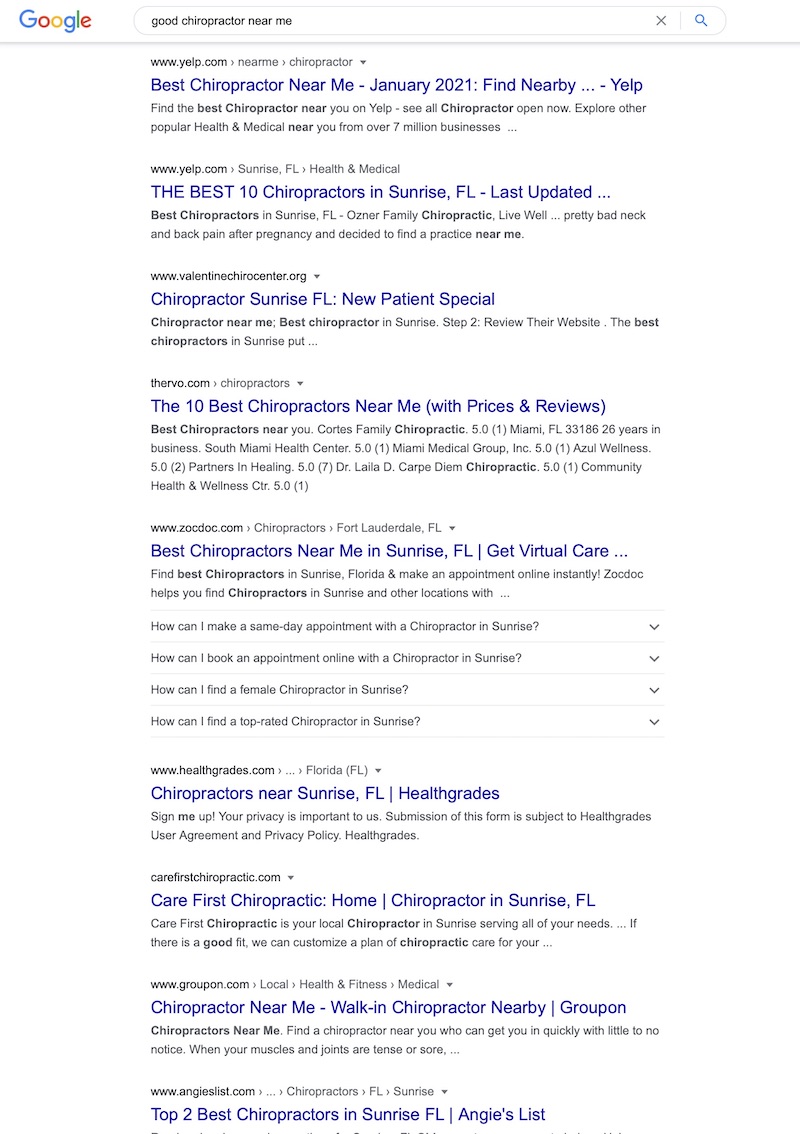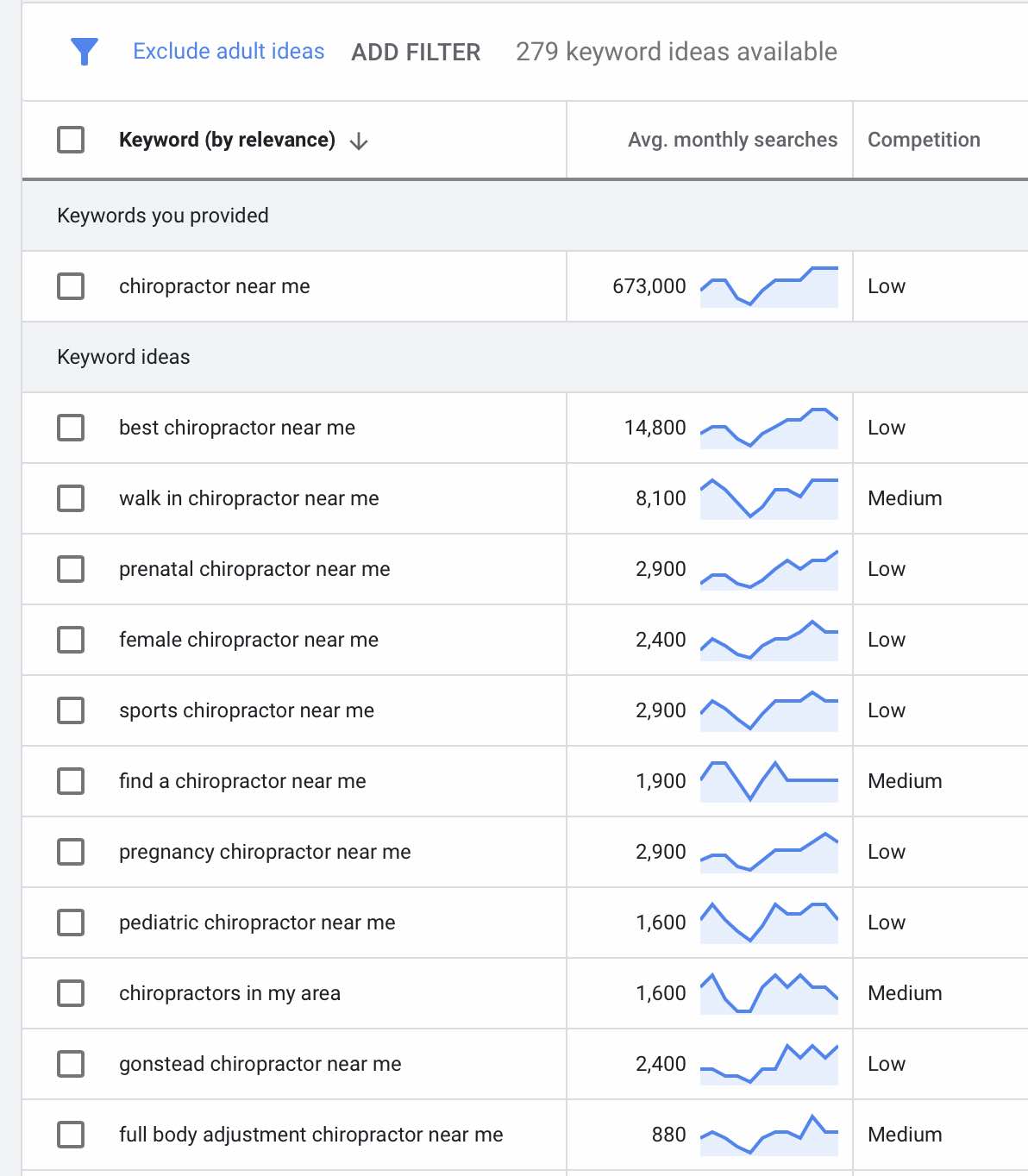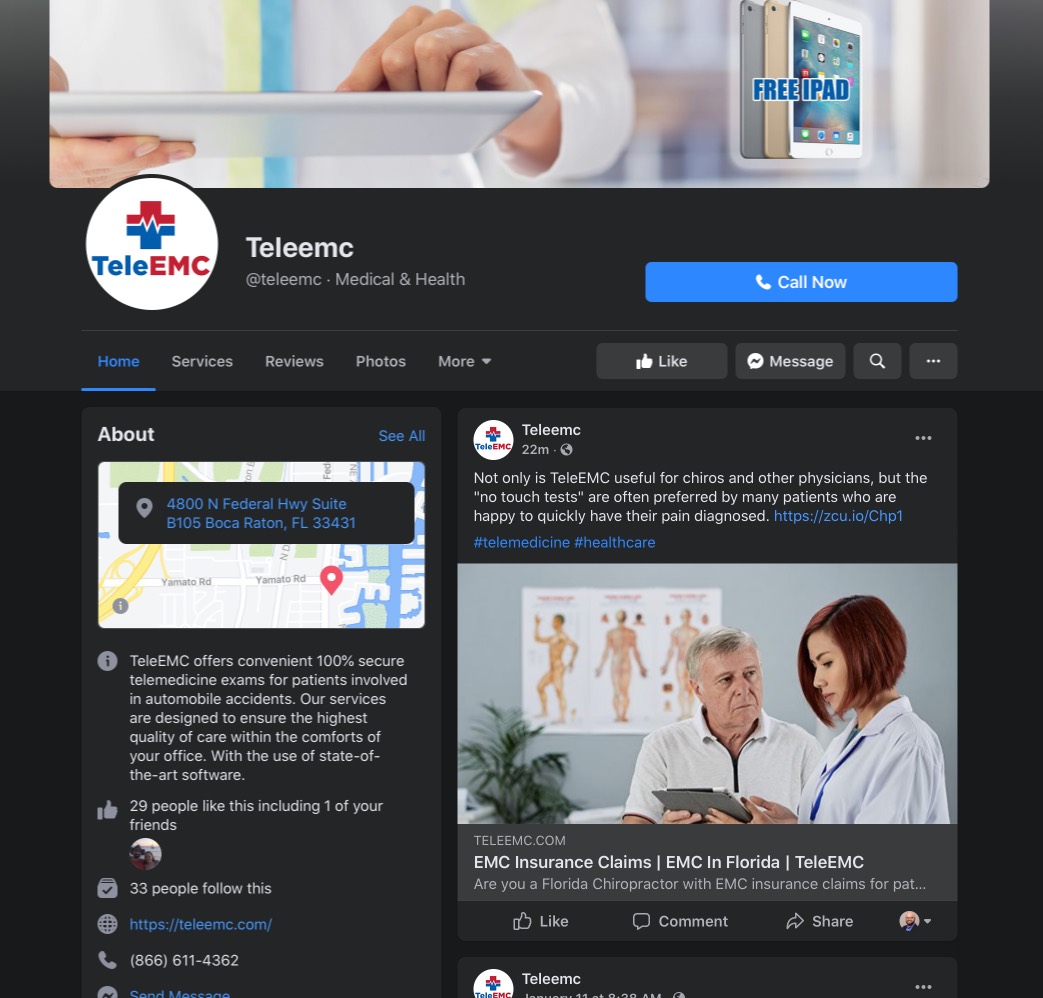Imagine that you’re a person who knows nothing about chiropractors, and you’re tasked with figuring out who is the best chiropractor in your area based on nothing but their website.
You can look at credentials or testimonials, but if you know little about chiropractors, that probably isn’t enough to guide your decision. Instead, you’re looking at the content – the writing and imagery on the site that helps you figure out:
- How trustworthy the chiropractor is.
- How much they know.
- How well they explain what you’re going to go through.
The more informative, engaging, and useful the chiropractor’s website is, the more it builds trust with the reader and proves that they are the best choice for your care.
Search engines work the exact same way.
When a search engine decides where to place a website for a search term (for example, if someone searches for “chiropractors in Jacksonville,” their algorithm looks at each chiropractor’s website and tries to determine, based on the quality and quantity of content, which website is most likely to be the best choice for that user’s query.
There are some other factors involved, such as website load speed, “backlinks” (links to your website from other people’s websites), and a few others, but the content on your website is, by far, your most important tool for helping your website improve its Google rank. This is part of an overall Chiro Marketing Guide!

An Introduction to SEO Copywriting
Creating a website that is designed to perform well in search engines goes by a lot of names, but is typically referred to as “search engine optimization” (optimizing your website for search result placement). So creating content that is designed to appeal to search engine algorithms is called “SEO Copywriting.”
SEO copywriting is easy to understand but difficult to master and complete. It requires both writing ability, time, and some experience, which is why many people use chiropractor SEO content writers to complete it for them. But a great way to save money is to create it on your own, and this guide is designed to show you how.


What is SEO Copywriting?
So now you know you need to create content. You know that content needs to appeal to search engine algorithms in order to help you show up higher in searches, so that you can get more clicks and, ultimately, more patients.
But SEO copywriting has a few more requirements. These include:
- Keywords/Key Phrases – Search engine algorithms have intense programming designed to be intelligent. It is a computer that can “read” content to determine what it is about and assign it to different search terms. But while the algorithms are smart, they are not geniuses. The best way to make sure search engines know what pages should show up depending on the user query is to integrate key words or key phrases into your content that are relevant to a person’s search.
- Unique – You can’t prove you’re the best by cheating. Stealing, or otherwise plagiarizing content from other websites will immediately discount your content in search engines, and could potentially trigger a punishment. You can use other sites as references, but the algorithm is smart enough to tell if someone copied even pieces of their content from other sites. It has to be new.
- Interesting/Informative – A 150 word, poorly worded blurb is not as interesting or informative as a 1000 word, detailed informative piece. Length matters, with a loose minimum of 350 words and a more=better approach to writing. Details also matter. The content should be written to provide a great answer to the user’s query, rather than be a piece thrown online with no value.
- Specific – It’s okay to have long overview pages that go over many different topics in depth. Indeed, that’s actually a great way to create content. But specific content is also useful. For example, talking about a specific treatment you offer provides more SEO benefits than briefly glossing over many different treatments without going into much detail.
- Easy to Navigate – Finally, part of what search engines are looking for is content that users will want to read. This is not an exact science, but these algorithms have data that can tell them when content is more “readable.” One example: shorter paragraphs with clear subheadings and bullet points. The algorithms have data that shows that people do not like to read giant walls of text, and so making sure your writing is easy to read and navigate is a part of SEO.
Outstanding SEO content writing can have some intricacies that make it a bit more complicated to do perfectly. But if all you do is follow the above list, you’ll still create a website that will perform better than the vast majority of your local competitors.
The following are some additional tips and tools to perform SEO copywriting better.

Finding Keywords

Although they’re called “keywords,” the term refers to any word or phrase relevant to a business, no matter the number of words involved. “highly rated chiropractor near me” is still considered a keyword.
Typically, you want to target keywords that receive many searches and are also relevant to your business and what your patients may be looking for. Obviously, the best possible keyword is just “chiropractor” or some variation, but single-word keywords are both far more competitive and will occur naturally in the text anyway, so what you’ll want to discover is the more specific phrases that may not occur naturally without help, and should have less competition.
There are many online tools that can help you with this, including:
- Ahrefs
- Google Keyword Planner
- SEM Rush
- Keywordtool.Io
- Moz Explorer
There are many free tools out there that are highly regarded as well for research or inspiration. You can integrate more than one keyword into a page, especially if it is directly relevant (for example: “treatment for back pain” and “back pain treatment” are two separate keywords, but share a topic) and you can also determine your “core keywords” which you can integrate into everything you write to help search engines recognize it is a core part of your business.
Do not “keyword stuff” (putting too many keywords in the content) and do not worry too much if you miss an important, close keyword. These algorithms do understand context, and can determine keywords relevant to your page even if they’re not in the text itself. But having the keyword within the text ensures search engines notice it.
Unique, High Quality, High Quality, and Engaging
Every single word you write for your site should be written from scratch. References are useful to get information if needed, but the words themselves need to flow from your fingers in every possible way.
The writing also has to be of high quality. There are grammar editing tools within Microsoft Word or Grammarly, which can help if grammar and spelling are not your strength. There should also be a lot of content, if possible – not only for each topic you write about, but also writing about multiple topics. Search engines like websites that are hubs of information, and so the more topics you write about on your site with interesting content, the better:
- Pages About Your Services
- Pages About the Conditions You Treat
- Pages About Insurance
- Blog Posts About Back Pain
- Frequently Asked Questions
- Case Studies
These are all just some examples of the types of content you can write about and what you can do with them. Have you or a website manager place these items as pages or posts on your site to give them visibility, and add relevant posts to your menu or footer.
All content also needs to be engaging. Writing needs to be able to draw the reader in. This can take some experience. You can ask people to read it to see if it feels engaging, or you can install tools like Google Analytics to see if the “time on page” or “bounce rate” (number of people that see a page and immediately leave) are strong numbers, both of which indicate that someone spent time reading it.
You should also add a form or links within the text. Engaging content will get people to click on links or fill out forms, helping give you more data to determine if the text was interesting to people.
Layout and Internal Links
In addition to making the writing itself engaging, it is in your best interests to make sure that people stay on the site after they read your work. To do that, you need to make sure they:
- Find What They Need – We mentioned earlier that layout was important, and that you can’t just have a giant wall of text. Headings, subheadings, formatting, and bullet points all make it easier for readers to navigate to the information they need. Headers, using H1, H2, H3, etc. formatting, can also add a visual appearance to the text that also makes it more appealing.
- Next Steps/Internal Links – There isn’t much value in having someone read content and leave. Some search engines, including Google, also do not like it. These search engines look to see if those reading the content take an extra step. In addition, that extra step also builds trust and conversions. Make sure there are links to other pages on your site with more information, and also make sure you always have a call to action, such as “call us for more information,” “fill out the form below,” or “click here to read more about XYZ.” That way the user continues to move along the pipeline, until eventually they call you.
These steps help to ensure that your content isn’t only well written, but created in such a way that it helps you achieve your ultimate goal – turning into new patients.

Sharing Your Content and Getting Links
We haven’t explored this yet in the context of chiropractor SEO copywriting, but once you’ve created a page for your site, you still want it to be seen. The goal is for it to show up in search engines, but that can take time, and you want to make sure that it gets out there.
For this, you’ll want to share your content:
- Post it on social media, including Facebook, Twitter, LinkedIn, and more.
- See if colleagues or others in the industry might be willing to link to it.
- If it’s about a new topic, consider a press release submitted to Newswire or PRWeb.
- Email it to your current and past patients, and more.
Not only will these help your content work for you, they can also help you develop your social media accounts and provide you with another important SEO tool, a backlink, that is separate from SEO copywriting but still valuable for helping your show up high in search engine ranks.


Review, Publish, and Repeat – Or Get the Help You Need
Once your content is written, publish it online, and keep going. You can never have too much content on your website, and it’s a great way to use your knowledge to build not only a great website, but also one with a strong search engine presence. You can also hire someone to do this writing for you by searching for “SEO content writer for chiropractors” and see those working within the industry.
At TeleEMC, we also have 3rd party connections that we can recommend to you if you contact us.Copywriting is only one tool that chiros can use to market their website, but it is an effective one, and it is a good idea for those in the industry to strongly consider it when examining their marketing investments.











